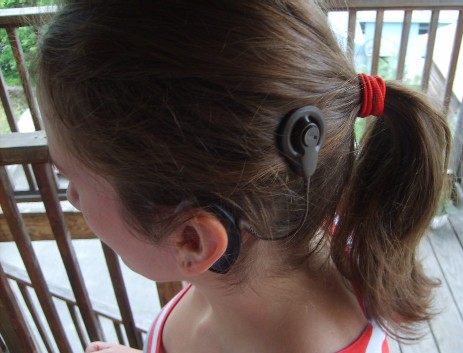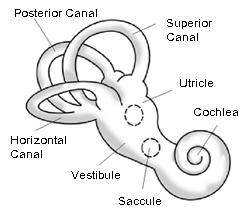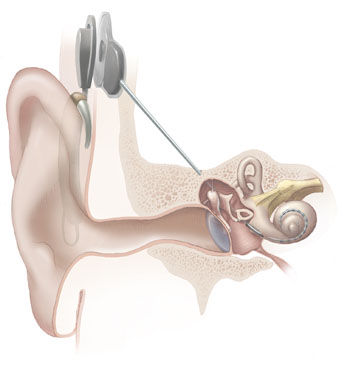How Cochlear Implants Work
The Cochlea
Cochlea (pronounced 'coke lee uh'): This is a portion of the inner ear that looks similar to a nautilus or snail shell1. (see image below). It's function is to convert sound waves entering the inner ear and covert those sounds into electrical impulses that the brain interprets as sound. The cochlea is basically a tapered tube that is coiled around itself. The larger portion of the tube interprets lower register sounds such as drum beats, cello or base guitar notes. The narrower portion of the cochlea interprets the higher register sounds such as bird-song, notes played on a violin, or perhaps the sound one would hear coming from a small bell.
The internal structure of the cochlea is filled with a thin watery liquid which moves back and forth in response to sounds coming into the inner ear. The fluid actually consists of water, proteins, and electrolytes. As this fluid moves tens of thousands of hair-like cells are set in motion. These "hairs" are connected to nerve endings which react to the motion of the "hair's" movement. These nerve impulses, in turn, are sent to the brain which interprets these signals as sound.
1 The Greek kokhlias means snail



The Implant
Cochlear implants consist of five (5) major parts.
The external components are:
- A microphone which picks up sound from the environment. The microphone is typically placed behind the ear in a fashion similar to earlier models of hearing aid
- A speech processor which selectively filters sound to prioritize the types of sound the user is most interested in hearing. In most cases this is audible speech, however musicians with hearing impairment may wish their implant to be tuned to the sounds produced by musical instruments. Regardless of the tuning, these signals are sent through a thin cable to the transmitter.
- A transmitter, which is an electromagnetic coil held in position by a magnet. The transmitter is position directly opposite the internally mounted receiver/stimulator inside the skull. It transmits the processed sound signals to the internal device by electromagnetic induction
The internal components are:
- A receiver and stimulator secured in bone beneath the skin,
which converts the signals into electric impulses and sends them
through an internal cable to electrodes. The electrodes are typically mounted in a very thin hypoallergenic plastic tube which is placed within the cochlea following the coil shape of that structure.
- The electrodes can be an array of up to twenty-two (22) electrodes wound through the cochlea. These electrodes by-pass the need for the "hairs" within the cochlea to respond to sound and send the electrical impulses normally created by these "hairs" directly to the nerve cells which, in turn, carry the "sound signals" to the brain.
There are currently four (4) manufacturers for Cochlear implants. Each manufacturer has a slightly different design for the implant with a different number of electrodes. The design of each and the number of electrodes has a definite impact on the cost of the offered implants.
The American company Advanced Bionics produces implants with 16 electrodes and use a propriety deign which causes it's sixteen electrodes to act like thirty-two or more. The technique is called "current steering." With this technique two electrodes are activated at the same time, but with varying degrees of stimulation to each of the two. Of course this steering is done at high speed with all sixteen (or eight pairs) of electrodes. This along with the signal processing algorithm determine both the accuracy and quality of the "sound" signals processed by the implant.
The Advanced Bionics model is one of the most expensive, but can be fine tuned by the patient and technician to a very high degree of accuracy. This is the manufacturer that musicians and sound technicians prefer. Advanced Bionics is the only company of the four that is American.
Cochlear Limited of Australia, MED-EL of Austria and Neurelec, of France are the other three manufacturers of implants. As of this writing Cochlear Limited designs the least expensive of the implants.
Implant Candidates
Implants are not for just anyone suffering a hearing loss. They are typically recommended for young children who have a better chance of adapting to the implant and to patients who have suffered a hearing loss relatively recently.
Factors used to determine ideal candidates are:
- Having severe to profound sensorineural hearing impairment in both ears
- Having a functioning auditory nerve (this is very important)
- Having lived at least a short amount of time without hearing (approximately 70+ decibel hearing loss, on average).
- Having good speech, language, and communication skills in the case of adults
- Having a family willing to work
toward speech and language skills with therapy for young children
- Not benefitting enough from other kinds of hearing aids
- Having no medical reason to avoid surgery
- Living in or desiring to live in the "hearing world"
- Having realistic expectations about results
- Having the support of family and friends
- Having appropriate services set up for post implant rehabilitation (this is often included in the cost of the procedure).
List source wikipedia
Costs
In the United States cochlear implant costs and run anywhere from $45,000 to $105,000. The cost typically includes evaluation, surgery, the hardware implant, hospitalization, and rehabilitation. The national average for this procedure is $60,000.
Though some or all of these costs may be covered by insurance, many insurance companies will only cover the cost of one implant; not two.
This limitation in coverage has had an interesting effect. Adult implant recipients with hearing loss in both ears typically have the right ear fitted with an implant. This is so they can hear their mate, while driving a car, assuming the mate is sitting in the passenger seat. This situation means that in the United States, more right side implants are performed than left side.
Difference in Natual Sound and Sound via Implant
Patients who had normal hearing before reported short learning curves in getting used to the implants. Some have reported having no trouble speaking to people they know. Telephone conversations are also possible.
Patients have also reported that if they are speaking to someone new there might be a brief period where the new speaker's voice is difficult to interpret at first. Problems are also reported where a conversation with multiple participants might be difficult to follow.
Others have described the sound quality as somewhat robotic or as if the speakers had laryngitis. Yet, other recipients described the sounds heard during the first few weeks as somewhat like radio static or speech even having a "cartoon" quality. In all cases the recipients report that over time speech and other sounds improve and sound normal.
This indicates that some degree of brain plasticity may be at play.
Drawbacks and Risks
Drawbacks
Since the implant is permanent and the effect of the surgery is irreversible there are some definite drawbacks. The sheathed tube containing the electrode that is inserted into the cochlea damages nerve cells there. This means that patients who had partial hearing in certain ranges will lose that natural ability once the implant is installed. Though improvements have been made in the surgical technique damage still occurs.
No implant made today has the same sound quality as natural hearing. This may be due, in part, to the brain's ability to reinterpret sound and "learn" to "normalize" the different quality of signals coming from the implant as compared to natural sound.
The condition of the patient's cochlea is also a factor with younger patients typically faring better than older patients. This is due, at least in part, to the physical condition of the cochlea itself.
Cochlear implants must be custom programmed for each individual patient. Of course, this is one factor in the high cost of the implant.
The transmitter portion of the device runs on batteries which must be replaced from time to time.
Risks
Food and Drug Administration research shows that cochlear implant patients may be at a higher than normal risk for meningitis.
An FDA funded study of 4,000 American children who received implants (between 1997 and 2002) determined that those children had a higher risk of pneumococcal meningitis; thirty (30) times higher than normal in fact.
A similar study in the United Kingdom found that adults ran a higher risk of meningitis in implant patients than the general population.
Because of this increased risk the Centers for Disease Control and Prevention and the FDA now recommend that implant recipients be vaccinated against meningitis shortly prior to the implant surgery.
Necrosis (cell death) has been observed in some patients. This cell death occurs in the skin surrounding cochlear implants.
Because the implant only works with patients with function nerve cells in the cochlea, extensive testing is typically performed on each patient to determine candidacy. This long before surgery is even considered.










